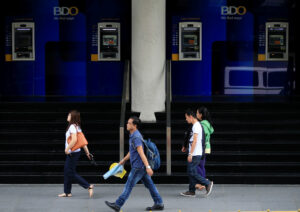By Karis Kasarinlan Paolo D. Mendoza, Researcher
THE COMBINED ASSETS of the Philippines’ biggest banks rose in the second quarter amid faster economic growth.
The latest edition of BusinessWorld’s quarterly banking report showed that the collective assets of 43 out of 44 universal and commercial banks grew by 10.7% year on year to P25.09 trillion in the second quarter from P22.67 trillion in the same period a year ago.
This was slightly faster than the 10.54% growth logged in the first three months of the year, and the fastest since 11.25% in the first quarter of 2023.
Total loans of these big lenders went up by 14.01% to P12.81 trillion in the April-to-June period, faster than 8.22% last year.
This was also the fastest loan growth in over five years or since 15.13% in the final quarter of 2018.
The growth in assets and lending may be attributed to the Philippine economy’s faster growth. Gross domestic product (GDP) expanded by 6.3% in the April-to-June period, the fastest pace since the 6.4% in the first quarter of 2023. Businesses are likely to borrow more to support investment plans while consumers may take out loans when they expect higher incomes.
Meanwhile, the share of bad loans to the total loan portfolio, also known as the nonperforming loan (NPL) ratio, slipped to 3.25% in the second quarter from 3.6% in the previous quarter and 3.58% a year ago.
Loans are considered nonperforming if any principal and/or interest are left unpaid for over 90 days from the contractual due date or accrued interests for more than 90 days have been capitalized, refinanced, or delayed by agreement.
Meanwhile, the net NPL ratio went down to 1.49% in the second quarter from 1.5% in the first quarter.
The banks’ median return on equity (RoE), which is an indicator of profitability, jumped to 8.93% in the second quarter from 7.91% in the same period a year ago and 8.02% in the first quarter of 2024.
Additionally, the big banks’ median capital adequacy ratio (CAR) — which reflects the lender’s ability to absorb losses from risk-weighted assets — fell to 18.8% for the period from 21.75% in the same period last year,
The ratio remained well above the regulatory minimum of 10% set by the BSP as well as the international minimum standard of 8% under the Basel III framework.
The leverage ratio — which gauges the institution’s ability to absorb shocks by measuring the bank’s capital relative to total exposure — stood at a median of 11.17% during the period. This exceeded the central bank’s 5% guideline as well as the international standard of 3%.
Meanwhile, the net interest margin inched up to 3.42% from 3.41% in the previous quarter.
During the April-to-June period, the return on assets, which measures the profit generated per peso of an asset, slipped to 1.42% from 1.61% in the first quarter.
BDO Unibank, Inc. (BDO) remained the largest bank in terms of total assets with P4.63 trillion, followed by Metropolitan Bank & Trust Co. (Metrobank) with P3.41 trillion and Land Bank of the Philippines (LANDBANK) with P3.34 trillion.
The Sy-led BDO also led the industry in loans with P3 trillion, followed by Bank of the Philippine Islands (BPI) with P2.07 trillion and Metrobank with P1.63 trillion.
BDO also had the most deposits with P3.73 trillion, followed by LANDBANK and BPI with P2.97 trillion and P2.45 trillion, respectively.
Among banks with at least P100 billion assets, Security Bank Corp. logged the fastest year-on-year asset growth with 31.32%, followed by The Hongkong & Shanghai Banking Corp. Ltd. (23.32%) and China Banking Corp. (19.53%).
Meanwhile, Maybank Philippines, Inc. posted the largest growth in loans at 36.8%, followed by Philippine Trust Co. with 32.43% and MUFG Bank Ltd. with 26.7%.
The report does not include Citibank N.A.’s statement of condition (SoC), which was not available during the collection period ending Aug. 30.
BusinessWorld Research has been tracking the financial performance of the country’s large banks quarterly since the late 1980s using banks’ published SoCs.
